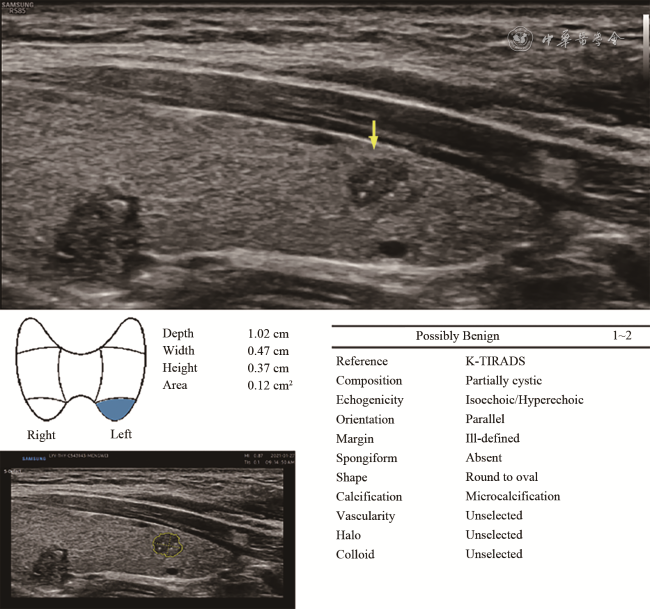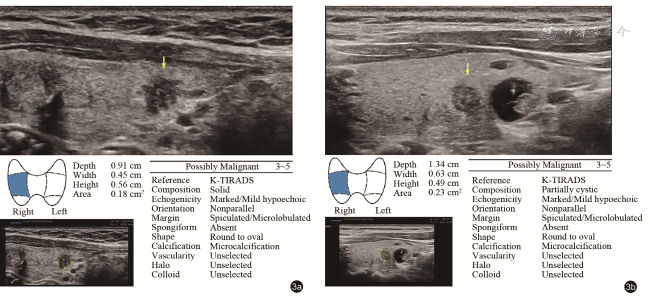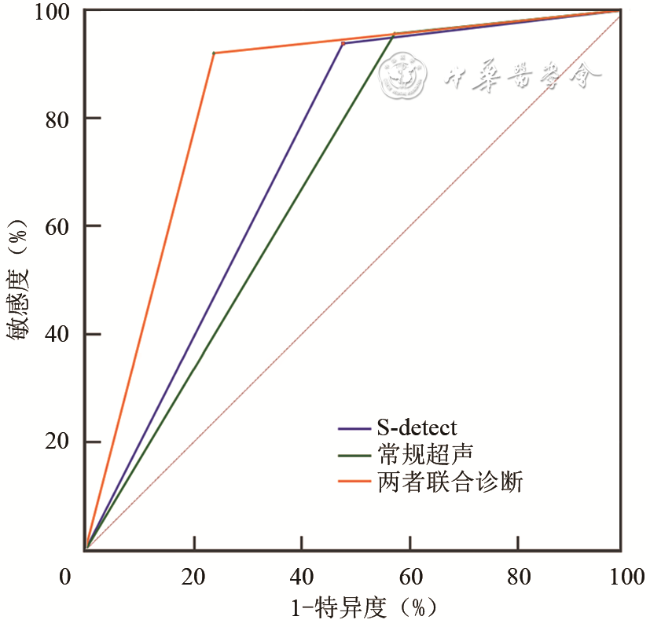资料与方法
一、对象
二、仪器与方法
三、统计学分析
结果
一、一般临床情况
表1 133例甲状腺结节患者一般临床资料 |
| 特征 | 良性 | 恶性 |
|---|---|---|
| 患者(例) | 21 | 112 |
| 结节(个) | 21 | 112 |
| 男性/女性 | 2/19 | 20/92 |
| 年龄(岁, ±s) | 47.57±6.67(37~56) | 41.93±9.93(23~72) |
| 结节最大直径(cm, ±s) | 0.75±0.20(0.36~0.98) | 0.69±0.18(0.30~1.00) |
注:年龄和结节最大直径括号内为范围值 |
二、住院医师、S-detect技术和两者联合的诊断效能
图1 S-detect技术鉴别最大径≤1 cm甲状腺结节良恶性的漏诊病例。甲状腺左叶下等/稍低回声实性结节,边界模糊,形态欠规则,内可见多发点状强回声,S-detect技术诊断为良性可能,病理结果为甲状腺乳头状癌 |
图2 S-detect技术与常规超声联合诊断最大径≤1 cm甲状腺结节良恶性的正确病例。图a示甲状腺右叶下低回声实性结节,边界模糊,形态欠规则,常规超声诊断为良性可能,S-detect技术诊断为恶性可能,病理结果为甲状腺乳头状癌;图b示甲状腺右叶中部稍低回声结节,边界不清,形态尚规则,常规超声诊断为良性可能,S-detect技术诊断为恶性可能,病理结果为甲状腺乳头状癌 |
表2 常规超声、S-detect技术及两者联合诊断结果 |
| 诊断方法 | 病理结果 | 合计 | |
|---|---|---|---|
| 良性 | 恶性 | ||
| 常规超声 | |||
| 良性 | 9 | 5 | 14 |
| 恶性 | 12 | 107 | 119 |
| S-detect技术 | |||
| 良性 | 11 | 7 | 18 |
| 恶性 | 10 | 105 | 115 |
| 联合诊断 | |||
| 良性 | 16 | 9 | 25 |
| 恶性 | 5 | 103 | 108 |
| 合计 | 21 | 112 | |
表3 常规超声、S-detect技术及两者联合诊断TI-RADS 4类最大径≤1 cm甲状腺结节良恶性的诊断效能 |
| 诊断方法 | 曲线下面积 | 准确性(%) | 敏感度(%) | 特异度(%) | 阳性预测值(%) | 阴性预测值(%) |
|---|---|---|---|---|---|---|
| 常规超声 | 0.692(0.606~0.769) | 88.0(81.5~93.0) | 95.5(89.9~98.5) | 42.9(21.8~66.0) | 89.9(84.4~95.4) | 64.3(35.6~93.0) |
| S-detect技术 | 0.731(0.647~0.804) | 87.2(81.5~93.0) | 93.8(89.2~98.3) | 52.4(29.1~75.7) | 91.3(86.1~96.5) | 61.1(36.2~86.1) |
| 联合诊断 | 0.841(0.767~0.898) | 89.5(84.2~94.8) | 92.0(85.3~96.3) | 76.2(52.8~91.8) | 95.4(91.3~99.4) | 64.0(43.8~84.2) |
| P值a | 0.522 | 1.000 | 0.754 | 0.687 | - | - |
| P值b | 0.007 | 0.648 | 0.388 | 0.016 | - | - |
| P值c | 0.028 | 0.629 | 0.774 | 0.063 | - | - |
注:TI-RADS为甲状腺影像报告和数据系统;a为S-detect技术与常规超声比较,b为联合诊断与常规超声比较,c为联合诊断与S-detect技术比较;“-”表示未进行统计比较,括号内数据为95%可信区间 |





